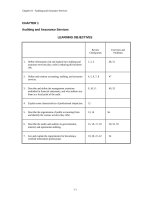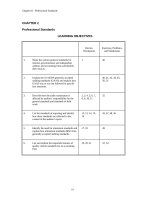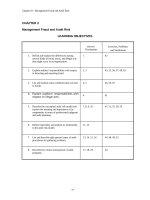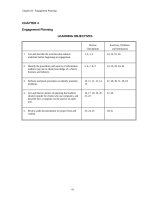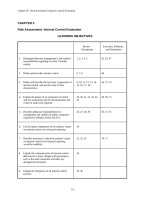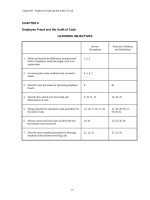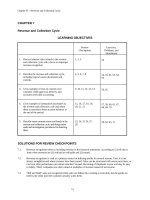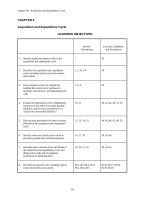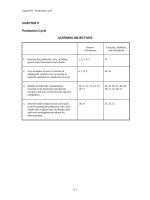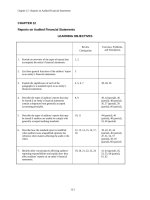Solution manual auditing and services 2e by louwers chap002
Bạn đang xem bản rút gọn của tài liệu. Xem và tải ngay bản đầy đủ của tài liệu tại đây (176.86 KB, 20 trang )
Chapter 02 - Professional Standards
CHAPTER 2
Professional Standards
LEARNING OBJECTIVES
Review
Checkpoints
1.
Name the various practice standards for
internal, governmental, and independent
auditors and accounting firms and identify
their sources.
2.
Explain the 10 AICPA generally accepted
auditing standards (GAAS) and explain how
GAAS was or was not followed in specific
fact situations.
3.
Describe how the audit examination is
affected by auditors’ responsibility for the
general standards and standards of field
work.
2, 3, 4, 5, 6, 7,
8, 9, 10, 11
55
4.
List the standards of reporting and identify
how these standards are reflected in the
content of the auditors’ report.
12, 13, 14, 15,
16
43, 47, 48, 56
5.
Identify the need for attestation standards and
explain how attestation standards differ from
generally accepted auditing standards.
17, 18
49
6.
List and explain the important features of
quality control standards for an accounting
firm.
19, 20, 21
52, 54
2-1
1
Exercises, Problems,
and Simulations
46
40, 41, 42, 44, 45,
50, 51
Chapter 02 - Professional Standards
SOLUTIONS FOR REVIEW CHECKPOINTS
2.1
For independent auditors of financial statements, practice standards are issued by the AICPA
Auditing Standards Board (in the form of Statements on Auditing Standards) and the Public
Company Accounting Oversight Board (in the form of Auditing Standards). Statements on
Auditing Standards are appropriate for the audits of nonpublic entities, while Auditing Standards
are appropriate for the audits of public entities.
For governmental auditors, the Government Accountability Office issues Government Auditing
Standards (also known as the “Yellow Book”).
For internal auditors, the Institute of Internal Auditors issues Statements of Internal Auditing
Standards (also known as the “Red Book”).
For fraud auditors, the Association of Certified Fraud Examiners issues Professional Standards
and Practices for Certified Fraud Examiners.
For auditors in other countries, the IFAC International Auditing and Assurance Standards Board
issues International Standards on Auditing and Assurance.
2.2
Auditing procedures relate to acts to be performed during the engagement. Auditing standards deal
with measures of the quality of performance of those acts and the objectives to be attained.
Auditing standards are less subject to change and provide the criteria for rejecting, accepting, or
modifying auditing procedures in a given circumstance.
An example of the relative stability of standards and procedures is found in the change from
non-computerized information systems to computerized information systems. New auditing
procedures were required to evaluate computerized information systems, but auditing standards
remained unchanged and were the criteria for determining the adequacy of the new auditing
procedures.
2.3
The standard for due professional care is the care that would be exercised by prudent auditors.
The prudent auditor is one who exercises reasonable judgment, who is not expected to be
omniscient, who is presumed to have knowledge special to his or her profession, who is expected
to be aware of his or her own ignorance, and who is expected to possess the skills of the profession
whether a beginner or a veteran.
2.4
Independence in fact represents auditors’ mental attitudes (do auditors truly act in an unbiased and
impartial fashion with respect to the client and fairness of its financial statements?). Independence
in appearance relates to financial statement users’ perceptions of auditors’ independence.
Auditors can be independent in fact but not perceived to be independent. For example, ownership
of a small interest in a publicly traded client would probably not influence auditors’ behavior with
respect to the client. However, it is likely that third-party users would not perceive auditors to be
independent.
2.5
Three elements of planning and supervision considered essential in audit practice are:
A written audit program.
An understanding of the client’s (auditee’s) business.
Policies to allow an audit team member to document disagreements with accounting or
auditing conclusions and disassociate him or herself from the matter.
2-2
Chapter 02 - Professional Standards
2.6
The timing of the auditors’ appointment is important because auditors need time to properly plan
the audit and perform the necessary work without undue pressure from tight deadlines.
2.7
Auditors obtain an understanding of a client, including its internal control, as a part of the control
risk assessment process primarily in order to plan the nature, timing and extent of substantive
audit procedures. A secondary purpose is because of auditors’ responsibilities for reporting on
client’s internal controls under Auditing Standard No. 5.
2.8
As the client’s internal control is more effective (a lower level of control risk), the necessary
effectiveness of auditors’ substantive procedures is reduced (a higher level of detection risk).
Conversely, when the client’s internal control is less effective (a higher level of control risk), the
necessary effectiveness of auditors’ substantive procedures is increased (a lower level of detection
risk).
2.9
Evidence is defined as the information used by auditors on which to base their opinion on the
financial statements.
2.10
External documentary evidence is audit evidence obtained from another party to an arm’s-length
transaction or from outside independent agencies. External evidence is received directly by
auditors and is not processed through the client’s information processing system.
External-internal documentary evidence is documentary material that originates outside the bounds
of the client’s information processing system but which has been received and processed by the
client.
Internal documentary evidence consists of documentary material that is produced, circulates, and
is finally stored within the client’s information processing system. Such evidence is either not
circulated to outside parties at all or is several steps removed from third-party attention.
2.11
In general, evidence that is completely external in nature is most reliable, because the client has
not influenced its processing. In contrast, evidence that is completely internal in nature is least
reliable, as it may represent a fictitious transaction created or modified by client personnel to
enhance perceptions of the client’s financial statements.
2.12
Financial Accounting Standards Board, Financial Accounting Standards Advisory Board, and
Governmental Accounting Standards Board statements are the highest level of authoritative
support for GAAP. Textbooks, handbooks, and journal articles are the lowest level.
2.13
Yes. The unqualified opinion sentence in the auditors’ report implies, among other things, that the
accounting principles used by the entity are appropriate in the circumstances.
2.14
Two messages are usually implicit in the auditors’ standard report: (1) the extent and
informativeness of disclosures are adequate, and (2) the accounting principles have been
consistently applied. By implicit, these matters are only mentioned in the auditors’ report if
concerns are noted by auditors.
2-3
Chapter 02 - Professional Standards
2.15
Four types of opinions and their messages:
Type
Unqualified opinion
Message
Financial statements are presented in conformity with GAAP.
Adverse opinion
Financial statements are not presented in conformity with GAAP.
Qualified opinion
Financial statements are presented in conformity with GAAP, except
for one or more departures or issues of concern.
Disclaimer of opinion
An opinion cannot be issued on the financial statements.
2.16
Investors, creditors and other users tend to assume that financial statements are audited and
“everything is OK” whenever they know a public accountant has been associated with the client’s
financial statements. If an audit examination has not been performed, accountants need to make the
fact known so users will not be mislead (although through no fault of the accountant). If an audit
examination has been performed, accountants must report their work and conclusions for users’
benefit.
2.17
The purpose served by the attestation standards is to guide attestation work in areas other than
audits of financial statements.
2.18
The major differences between attestation standards and generally accepted auditing standards
(GAAS) lie in the areas of practitioner competence, risk of material misstatement, and reporting.
Some other differences are minor ones.
GAAS presume knowledge of accounting and require training and proficiency as auditors
(meaning auditors of financial statements). The attestation standards are more general, requiring
training and proficiency in the “attest function” and knowledge of the “subject matter of the
assertions.”
The attestation standards have no requirement regarding an understanding of an entity’s overall
environment, including internal control. Some types of subject matter that serve as the basis for an
attestation engagement may not be affected by the client’s internal control in the same sense as a
financial accounting and reporting system.
Reporting is different because attestations on nonfinancial information do not depend upon
generally accepted accounting principles. The attestation standards speak of “evaluation against
reasonable criteria,” and “conformity with established or stated criteria” and provide flexibility for
attestation engagements and services on a wide variety of informational assertions.
2.19
While GAAS relate to the conduct of individual audit engagements, quality control standards
govern the quality of an accounting firm’s accounting and audit practice as a whole.
Quality Control Standard No. 2 identifies five elements of quality control for an accounting firm.
When a peer review or quality review is conducted, the reviewers evaluate the firm’s statement of
policies and procedures designed to ensure compliance with the five elements. These statements
vary in length and complexity, depending upon the size of the accounting firm.
2.20
This is an example of a policy statement related to engagement performance as it relates to
consultation for assistance with difficult accounting and auditing problems.
2-4
Chapter 02 - Professional Standards
2.21
In addition to the standard setting role previously discussed, one of the primary roles of the Public
Company Accounting Oversight Board (PCAOB) is to monitor firms that audit public entities. The
Board’s goal is to ensure that audit quality is not compromised and that auditors’ performance
continues to meet public expectations. Soon after it began operations in early 2003, the PCAOB
began registering accounting firms providing auditing services to public entities. Firms not
registered are not allowed to conduct audits of public entities. Other PCAOB monitoring activities
include conducting inspections of registered accounting firms (similar to peer reviews), special
investigations, and disciplinary proceedings.
SOLUTIONS FOR MULTIPLE-CHOICE QUESTIONS
2.22
a.
b.
c.
d.
Incorrect
Correct
Incorrect
Incorrect
Due professional care is a general standard, not a standard of reporting.
This standard is a standard of reporting.
Sufficiency of evidence is a standard of field work.
While the auditors’ report does reference the use of GAAS in the audit
examination, this is not one of the standards of reporting.
2.23
a.
Incorrect
b.
c.
Incorrect
Incorrect
d.
Correct
This practice relates to accountants’ competence and training, not due
professional care.
This practice is a standard of reporting.
Sufficiency of evidence is a standard of field work and is not related to
due professional care.
These practices are a part of due professional care.
2.24
a.
b.
c.
d.
Incorrect
Correct
Incorrect
Incorrect
GAAS relates to the conduct of an audit engagement by auditors.
Quality Control Standards are firm- (rather than auditor-) related.
GAAP relates to accounting, rather than auditing practices.
International auditing standards govern the conduct of audits conducted
across international borders.
2.25
a.
Incorrect
b.
Incorrect
c.
Incorrect
d.
Correct
Auditors may lack training and proficiency in this case, but (d) is a
better answer.
Auditors may lack planning and supervision in this case, but (d) is a
better answer.
Auditors had enough investigative independence to identify the
problem.
Auditors let some feelings for the client override their obligations to the
users of the financial statements.
a.
b.
c.
Correct
Incorrect
Incorrect
d.
Incorrect
2.26
According to the second standard of field work.
Consulting suggestions are secondary objectives in an audit.
Information about the entity’s internal control is, at best, indirect
evidence about assertions in the financial statements.
Information about the entity’s internal control provides auditors with
little opportunity to learn about changes in accounting principles.
2-5
Chapter 02 - Professional Standards
2.27
a.
b.
Incorrect
Correct
c.
d.
Incorrect
Incorrect
a.
b.
Incorrect
Incorrect
c.
Incorrect
d.
Correct
a.
b.
Incorrect
Incorrect
c.
Incorrect
d.
Correct
2.30
c.
Correct
Initials of the preparer and reviewer provide evidence of due
professional care and planning and supervision.
2.31
a.
b.
Incorrect
Correct
c.
d.
Incorrect
Incorrect
Attestation standards require adequate knowledge of the subject matter.
An understanding of the client’s environment (including internal
control) is not required under attestation standards, because internal
control may not always be relevant to the subject matter of the
attestation.
Attestation standards require sufficient evidence is required.
Attestation standards require independence in mental attitude.
a.
b.
c.
Incorrect
Incorrect
Correct
d.
Incorrect
a.
b.
c.
Incorrect
Incorrect
Incorrect
d.
Correct
2.28
2.29
2.32
2.33
External evidence is quite reliable.
Representations from management should least affect auditors’
conclusions, as they have not been validated or corroborated by
external parties.
Auditor-prepared evidence is highest on the scale of appropriateness.
Although a representation of a client employee, inquiry of the entity’s
legal counsel is considered more reliable than that of entity
management.
Inquiry of management should least affect auditors’ conclusions.
Although very persuasive, auditors’ personal knowledge (choice d)
provides the most persuasive evidence
Observation of a client’s procedures provides evidence on the
effectiveness of the client’s internal control, but not the existence
assertion for newly acquired computer equipment.
Auditors’ personal knowledge provides the most persuasive evidence.
Inquires of client personnel are the least reliable form of evidence.
While more reliable than inquiries (choice a), inspection of internal
documents is a relatively unreliable form of evidence.
While sales invoices are documents created by external parties, the fact
that these documents were received from client personnel decreases
their reliability.
Because the bank statements were received directly from outside
parties, this is a more reliable form of evidence than choice (c).
EITF positions are in the third level of authoritative support.
AICPA industry guides are in the second level of authoritative support.
FASB statements on standards are in the first level of authoritative
support.
FASB statements on concepts are in the fourth level of authoritative
support.
Internal documents are a relatively low quality of evidence.
Written representations are the lowest quality of evidence.
While direct, external evidence is of reasonable quality, it is of lower
quality than direct personal knowledge of the auditor (choice d).
Direct, personal knowledge of auditors is the most appropriate form of
evidence.
2-6
Chapter 02 - Professional Standards
2.34
a.
Incorrect
b.
Incorrect
c.
Incorrect
d.
Correct
2.35
b.
Correct
Given the choices presented, the EITF position is ranked highest on the
GAAP hierarchy (see Exhibit 2.3).
2.36
b.
Correct
Government auditing standards are issued by the Government
Accountability Office (GAO). Governmental accounting standards are
issued by the Governmental Accounting Standards Board.
2.37
a.
Correct
b.
Incorrect
c.
Incorrect
d.
Incorrect
Consultation with a specialist demonstrates due professional care if
auditors do not have expertise in the area in question.
Auditors are experts in financial matters, not areas of art (and other
collectibles) valuation.
GAAS applies to all audit engagements, including audit engagements
for not-for-profit organizations.
Since (a) is correct, (d) cannot be correct.
2.38
2.39
While it may increase auditors’ knowledge about the client, obtaining
an understanding of a client’s internal control does not directly
influence auditors’ training and proficiency.
Obtaining an understanding of a client’s internal control does not
directly influence auditors’ independence.
Obtaining an understanding of a client’s internal control does not
directly help satisfy the quality control standard about audit staff
professional development.
The primary purpose of obtaining an understanding of a client’s
internal control is to plan the nature, timing, and extent of substantive
audit procedures on an engagement.
NOTE TO INSTRUCTOR: Since this question asks students to identify the standard that has not
been violated, the response labeled “correct” has not been violated and those labeled “incorrect”
have been violated.
a.
Incorrect
b.
Correct
c.
Incorrect
d.
Incorrect
a.
Correct
b.
c.
Incorrect
Incorrect
d.
Incorrect
Due professional care has not been followed in this case; as a result,
this standard has been violated.
The consistency standard relates to the consistent presentation of
financial information, not the consistent presentation of the auditors’
report. As a result, this standard has not been violated.
In this case, disclosures are not adequate; as a result, this standard has
been violated.
Footnotes are considered an integral part of the financial statements.
Failure to include an important footnote would be considered a
departure from generally accepted accounting principles, resulting in a
violation of this standard.
Attestation standards differ from generally accepted auditing standards
in that they apply to engagements other than those on the audited
financial statements.
Attestation standards require that the practitioner be independent.
Attestation standards may apply to prospective “what if” financial
statements.
Attestation standards include standards of field work.
2-7
Chapter 02 - Professional Standards
SOLUTIONS FOR EXERCISES AND PROBLEMS
2.40
Audit Engagement Independence
a.
Auditors should not follow clients’ suggestions about the conduct of an audit unless the
suggestions clearly do not conflict with their professional competence, judgment,
honesty, independence, or ethical standards. Where there is no disagreement about the
results to be accomplished and the client’s suggestions represent good ideas, auditors can
consider these suggestions. Within professional bounds, mutual agreement with the client
is acceptable. Auditors must never agree to any arrangement that violates generally
accepted auditing standards or the AICPA’s Code of Professional Conduct.
b.
The reasons that would not support dividing the assignment of audit work solely
according to assets, liabilities and income and expenses include the following:
1.
Work should be assigned to staff members by considering the degree of difficulty
in relation to the technical competence and experience of individual staff
members.
2.
Sequence of work performed on an examination should be in accordance with an
overall audit plan.
3.
It is impossible to segregate work areas by major captions because often a close
relationship exists among a number of accounts in more than one category. For
example, interest and dividend income are normally based on an asset
(investments) and interest expense is normally based on a liability (long-term
debt).
4.
Often a single form of audit documentation is desirable to provide evidence with
respect to balances in accounts of various types, such as an insurance analysis
supporting premium disbursements, the insurance expense portion, and the
prepaid insurance balance.
5.
Duplication of staff effort would be more likely to occur if assignments were
made on such a basis.
6.
Frequently, the scope of work regarding a single account requires simultaneous
participation by the staff, such as in the observation of inventories.
Many audit operations are not susceptible to division by category, as for example
investigating internal control, testing transactions, and preparing the report.
c.
The audit staff member whose uncle owns the advertising agency should not be assigned
to examine the client’s advertising account. The accounting firm is responsible for
avoiding relationships which might suggest a conflict of interest. Regardless of whether
this staff member could be independent and unbiased in such a situation (independence in
fact), external parties will likely be influenced in their thinking by the fact that the uncle
is the owner of the advertising agency (the staff member would not have independence in
appearance). Even if a problem of ethics were not involved, it would be unwise for the
accounting firm to assign this staff member because the client’s attitude could change
significantly and the firm’s position would be jeopardized if difficulties later arose in
connection with the contract. Any situation in which bias exists or might arise should be
avoided.
2-8
Chapter 02 - Professional Standards
2.41
Standards of Field Work
The three generally accepted standards of field work and their relation to the illustration are as
follows:
1.
The first standard of field work is that auditors must adequately plan the work and must
properly supervise any assistants. Fulfilling this standard would include the preparation
of an audit program for accounts receivable and reviewing it with the assistant prior to
beginning the examination. These things were not done. Also, the completed audit
documentation should have been reviewed to determine whether an adequate examination
was performed. The illustration states that this procedure was followed.
2.
The second standard of field work is that auditors must obtain a sufficient understanding
of the entity and its environment, including its internal control, to assess the risk of
material misstatement of the financial statements whether due to error or fraud, and to
design the nature, timing, and extent of further audit procedures. The case presented did
not reference any work on the internal control. Complete reliance upon prior-year audit
documentation in lieu of an evaluation of the existing internal control is improper,
because changes may have been implemented to the system and controls by the client.
3.
The third standard of field work is that auditors must obtain sufficient appropriate audit
evidence through audit procedures performed to afford a reasonable basis for an opinion
regarding the financial statements under audit. The assistant’s preparation of audit
documentation, confirmation requests, and other procedures seem to fulfill the
requirements of this standard if the audit work is properly performed and is of sufficient
scope.
2.42
Time of Appointment and Planning
2.43
From a theoretical viewpoint (and, in fact, from a practical viewpoint as well) such short notice of
a request for an audit causes difficulties with planning the audit work, with establishing staffing
requirements, and with reviewing the work; all of these features are important elements in the
exercise of due audit care. The December 26 - January 20 period is a serious time constraint for
an initial audit engagement. The greatest difficulties involve the third general standard (due
professional care) and the three standards of field work. In view of the short notice and the time
constraint, there may be some question as to whether an audit could be completed with due
professional care by January 20.
Standards of Reporting
2-9
Chapter 02 - Professional Standards
You must determine whether an unqualified opinion satisfies the standards of reporting, in
particular:
a.
Determine whether the financial statements are presented in conformity with generally
accepted accounting principles (GAAP).
1.
Read the footnote description of accounting policies.
2.
Use a GAAP checklist.
3.
Review the audit documentation for any indication of accounting policies not
described in the footnote or ones apparently not in conformity with GAAP.
4.
Refer to SAS criteria concerning the “meaning of present fairly” (SAS 69)
regarding determinations that:
(i)
The accounting principles are generally acceptable, having
authoritative support.
(ii)
The accounting principles are appropriate in the circumstances.
(iii)
The financial statements are informative.
(iv)
The information is reasonably summarized.
(v)
Material adjustments have not been waived without appropriate
justification.
b.
Determine whether any accounting changes have been made and whether accounting
principles have been applied consistently.
c.
Determine whether the footnote disclosures are adequate to inform users of any material
information evident in the audit documentation.
The fourth standard of reporting is not referenced above. However, the fact that an opinion has
been prepared would satisfy this standard.
2.44
GAAS in a Computerized Environment
The first general standard requires auditors to be properly trained and proficient. In an audit of a
computerized accounting system, adequate training and proficiency must be directly related to
information technology and controls in a computerized environment. In particular, auditors should
be knowledgeable of what computer systems do, how to test the operations of a computerized
accounting system, and how to use documentation unique to a computerized accounting system.
The second general standard relates to auditor independence. The training and proficiency
standard contributes to satisfaction of the independence standard by enabling auditors to make
their decisions and judgments. Otherwise, auditors might be inclined to subordinate their
judgments to other persons, possibly to client personnel. When auditors lack training and
proficiency, it is virtually impossible to maintain an operational independence over audit
decisions. An independence of mental attitude is futile if actual decisions are subordinated to
others.
The third general standard requires due professional care. The exercise of due professional care
requires a critical review of the work at every level of supervision and the decisions made by
auditors. Lacking the requisite skills and lacking independent decisions, the due professional care
expected of auditors at operational, supervisor, and review levels cannot be delivered.
2-10
Chapter 02 - Professional Standards
The first standard of field work requires adequate planning and supervision of assistants. Training
and proficiency in computerized accounting systems auditing is necessary for planning access to
computerized records and programs and conducting appropriate audit procedures. The planning
should provide for an early examination of the computerized accounting system so that further
procedures involving non-computer controls and accounting features may be planned should they
depend upon computer control procedures.
2.44
GAAS in a Computerized Environment (Continued)
The second standard of field work relates to assessing the risk of material misstatement, which
includes assessing both inherent risk and control risk. Training and proficiency are very important
for being able to obtain an understanding of a computerized accounting system’s internal controls.
Client personnel will expect audit personnel to be capable of working with a computer system.
The third standard of field work requires auditors to obtain sufficient appropriate audit evidence to
provide a basis for an opinion on financial statements. Documentary evidence relating to a
computerized accounting system includes program flowcharts, logic diagrams, and decision tables
that are not normally used in non-computerized systems. Since these types of documentation are a
part of the evidence, they must be understood by auditors; this understanding comes through
training and proficiency in their use.
2.45
Authoritative Support
SAS 69 (1992), amended by SAS 91 (1999), specifies the hierarchy of sources of authoritative
support. Refer to Exhibit 2.3 in Chapter 2.
2-11
Chapter 02 - Professional Standards
2.46
Sources of Professional Standards:
Description
2.47
Source
a.
Definition of a financial statement audit for a
private entity
a.
AICPA Auditing Standards Board
b.
Guidance for reporting on internal control for a
public entity
b.
PCAOB
c.
Standards for the practice of internal auditing
c.
Institute of Internal Auditors
d.
Generally accepted government auditing
standards
d.
U.S. Government Accountability Office
e.
Standards of financial accounting
e.
Financial Accounting Standards Board
f.
Auditing standards for public entities
f.
PCAOB (with AICPA Auditing Standards
Board serving as Interim Standards)
g.
Auditing standards for private entities
g.
AICPA Auditing Standards Board
h.
Guidance for lending credibility to nonfinancial
information
h.
AICPA Auditing Standards Board
(attestation standards)
i.
Auditing standards for foreign entities
i.
IFAC International Auditing and Assurance
Standards Board
Auditors’ Reports
a.
For scope limitations, the auditors’ report would be modified as follows:
The scope paragraph would be modified to indicate that “except for” the matter of
the scope limitation, the audit was conducted in accordance with generally accepted
auditing standards (for a qualified opinion). The scope paragraph would be omitted if
auditors issued a disclaimer of opinion.
An explanatory paragraph would be added to the auditors’ report to describe the
nature of the scope limitation, including dollar effects.
The opinion paragraph would be modified to either indicate that “except for” the
effects of adjustments that might have been identified, the financial statements are
prepared according to GAAP (qualified opinion) or to disclaim an opinion
(disclaimer of opinion).
Auditors can issue either a qualified opinion or a disclaimer of opinion when scope
limitations exist (assuming these limitations are material).
b.
For departures from GAAP, the auditors’ report would be modified as follows:
An explanatory paragraph would be added to describe the nature of the departure
from GAAP, including dollar effects.
2-12
Chapter 02 - Professional Standards
The opinion paragraph would be modified to indicate either that “except for” the
effects of the departure from GAAP, the financial statements are prepared according
to GAAP (qualified opinion) or that the financial statements are not prepared
according to GAAP (adverse opinion).
Auditors can issue either a qualified opinion or an adverse opinion when departures from
GAAP are noted (assuming these departures have a material effect on the financial
statements).
2.48
Association with Financial Statements
The consequence of being associated with financial statements is that the fourth standard of
reporting is invoked, which requires an indication of the nature of the examination and degree of
responsibility auditors are assuming to be clearly indicated in the report.
a.
Associated
Issue the auditors’ report.
b.
Not associated
Tax returns are an exception.
c.
Associated
Issue a disclaimer of opinion (public entity).
Issue a compilation report (nonpublic entity).
d.
Not associated
CPA is associated with accounting records but not with
financial statements.
e.
Associated
Issue a disclaimer of opinion (public entity).
f.
Associated
Issue a disclaimer of opinion (auditors should have requested
that the client not print the auditors’ name in this way.)
g.
Not associated
Nothing needs to be done so long as client doesn’t mention
auditors in the interim statement document.
2-13
Chapter 02 - Professional Standards
2.49
Investment Performance Attestation
1, 2.
Proficiency in the attest function and knowledge of the subject matter: Accountants must
be persons who know and understand investment statistics, operations of mutual funds,
and SEC rules regarding expenses.
3.
Reasonable criteria: Accountants must determine whether standards exist for presentation
of investment return statistics and expense ratios, or they must be able to assess the
reasonableness of management’s presentation of criteria. In addition, accountants must
determine whether the statistics can be evaluated against reasonable criteria that are
understandable by users of the advertisements.
4.
Independence: Accountants must determine that they have independence in relation to
Mystery Capital Management and its officers and directors.
5, 6, 7.
8,10.
Due care, planning and supervision, sufficient evidence: Accountants must conduct the
field work carefully to obtain the evidence necessary in the circumstances.
Report: The accountants’ report must identify the performance statistics and expense
ratios and relate them to the criteria upon which they are based.
9.
Reservations: If accountants have any misgivings about misrepresentation of the statistics
and ratios management presents, these representations must be stated in the report.
11.
Limitation on use of report: In some cases, the report may be intended solely for the
information and use of specified parties. As a result, it may not be appropriate for this
report to be presented in the entity’s advertisements.
2-14
Chapter 02 - Professional Standards
2.50
Auditing Standards Case Study
General Standards
1.
The auditor must have adequate technical
training and proficiency to perform the audit.
1.
It was inappropriate for Holmes to hire the two
students to conduct the audit. The examination
must be conducted by persons with proper
education and experience in the field of
auditing. Inexperienced persons can assist, if
they are supervised.
2.
The auditor must maintain independence in
mental attitude in all matters relating to the
audit.
2.
To satisfy the second general standard, Holmes
must be without bias with respect to the client
under audit. Because of the financial interest in
the bank loan, Holmes is neither independent in
fact nor appearance with respect to the
assignment undertaken.
3.
The auditor must exercise due professional
care in the performance of the audit and the
preparation of the report.
3.
This standard requires performing the audit
with due care, which imposes on everyone a
responsibility to observe the standards of field
work and reporting. Exercise of due care
requires critical review at every level of
supervision of the work done and the judgments
exercised. Holmes did not review the work or
the judgments of the assistants and clearly
failed to adhere to this standard.
Standards of Field Work
1.
The auditor must adequately plan the work and
must properly supervise any assistants.
1.
This standard recognizes that early appointment of
auditors has advantages for auditors and the client.
Holmes accepted the engagement without
considering the availability of staff. In addition,
Holmes failed to supervise the assistants. The
work performed was not adequately planned.
2.
The auditor must obtain a sufficient
understanding of the entity and its
environment, including its internal control, to
assess the risk of material misstatement of the
financial statements whether due to error or
fraud, and to design the nature, timing, and
extent of further audit procedures.
2.
Holmes did not study the client’s internal control
nor did the assistants. There appears to have been
no audit examination at all. The work performed
was more an accounting service than it was an
auditing service.
3.
The auditor must obtain sufficient appropriate
audit evidence through audit procedures
performed to afford a reasonable basis for an
opinion regarding the financial statements
under audit.
3.
No evidence was acquired to support the financial
statements. The auditors merely checked the
mathematical accuracy of the records and
summarized the accounts. Standard audit
procedures and techniques were not performed.
2-15
Chapter 02 - Professional Standards
2.50
Auditing Standards Case Study (Continued)
Standards of Reporting
1.
The auditor must state in the auditor’s report
whether the financial statements are presented
in accordance with generally accepted
accounting principles.
1.
The report made no reference to generally accepted
accounting principles. Because a proper
examination was not conducted, the report should
state no opinion can be expressed as to the fair
presentation of the financial statements in
accordance with generally accepted accounting
principles.
2.
The auditor must identify in the auditor’s
report those circumstances in which such
principles have not been consistently observed
in the current in relation to the preceding
period.
2.
The report makes no reference to the consistent
application of accounting principles. The improper
audit would not enable auditors to know whether
such implicit reporting was appropriate.
3.
When the auditor determines that informative
disclosures are not reasonably adequate, the
auditor must so state in the auditor’s report.
3.
Without footnotes, the financial statements cannot
contain adequate disclosure. Holmes’ report should
have referenced the lack of appropriate footnote
disclosures.
4.
The auditor must either express an opinion
regarding the financial statements taken as a
whole, or state that an opinion cannot be
expressed, in the auditor’s report. When the
auditor cannot express an overall opinion, the
auditor should state the reasons therefor in the
auditor’s report. In all cases where an auditor’s
name is associated with financial statements,
the auditor should clearly indicate the
character of the auditor’s work, if any, and the
degree of responsibility the auditor is taking,
in the auditor’s report.
4.
Although the report contains an expression of
opinion, such an opinion is not based on the results
of a proper audit examination. Holmes should
disclaim an opinion for failure to conduct an
examination in accordance with generally accepted
auditing standards.
2-16
Chapter 02 - Professional Standards
2.51
Generally Accepted Auditing Standards
a.
This situation is related to the second standard of reporting, which addresses the
consistent application of accounting principles. Because the change in accounting
standards is considered to be reasonable and has been properly accounted for and
disclosed, this change does not represent a departure from GAAP. However, the change
in accounting principle should be mentioned in the auditors’ report, based on the second
standard of reporting.
b.
This situation is related to the first general standard, which addresses the training and
proficiency of auditors. In this case, auditors can accept this engagement assuming that
they take appropriate measures to obtain the knowledge necessary to perform the audit
and understand important issues affecting this client. It is important to note that the
existence of industry-specific accounting issues will require auditors to obtain the
knowledge necessary to complete the engagement.
c.
This situation is related to the first standard of reporting, which addresses the conformity
of the financial statements with GAAP. If the client elects to treat these leases as
operating leases in violation of GAAP, auditors should issue either a qualified or adverse
opinion, depending upon the materiality of the departure from GAAP.
d.
This situation is related to the first standard of field work, which indicates that the audit
should be properly planned. In this case, auditors should evaluate whether the client’s
deadline will allow an audit to be properly planned and conducted according to generally
accepted auditing standards. The fact that this would be an initial audit makes this
possibility even more questionable than usual.
e.
This situation is related to the third standard of field work, which requires auditors to
obtain sufficient appropriate audit evidence. Given the low level of control risk, auditors
would then proceed to perform the necessary auditing procedures, which provide the
basis for their opinion on the client’s financial statements.
f.
This situation is related to the second general standard, which requires auditors to be
independent. In this particular case, the fact that one of the partner’s husband is an officer
of the prospective client would likely result in the firm declining this particular
engagement because of a lack of independence.
g.
2.51
This situation is related to the fourth standard of reporting, which requires auditors to
provide an indication of their work when their name is associated with financial
statements. Auditors can allow the financial statements to be printed on their letterhead,
assuming they prepare a report disclaiming an opinion on the fairness of these financial
statements.
Generally Accepted Auditing Standards (Continued)
h.
This situation is related to both the first standard of reporting (conformity of the financial
statements with GAAP) and third standard of reporting (adequacy of disclosures).
Auditors should insist upon disclosure of the potential litigation and, if the client refuses,
issue either a qualified opinion or adverse opinion, depending upon the materiality of the
omission of the disclosures. In addition, the auditors’ report should provide information
regarding the omitted disclosures.
2-17
Chapter 02 - Professional Standards
2.52
i.
This situation is related to the second standard of field work, which requires auditors to
obtain an understanding of their clients and internal controls. Once this understanding has
been obtained, auditors would then proceed to perform the necessary substantive audit
procedures.
j.
This situation is related to the third general standard, which addresses due professional
care. An important element of due professional care is critical review of work performed
by persons at various levels within the firm. Because the supervisor’s review of the work
performed by the assistant indicates that the work supports the opinion on the financial
statements, no further actions are necessary.
Quality Control Standards
a.
b.
c.
d.
e.
f.
g.
h.
i.
2.53
Personnel management (advancement and performance)
Engagement performance
Engagement performance (consultation)
Personnel management (assignments)
Personnel management (hiring)
Personnel management (professional development)
Monitoring
Independence, integrity and objectivity
Acceptance and continuance of clients
Relative Appropriateness of Evidence
a.
Audit evidence obtained from independent sources outside the client provides greater
assurance of reliability (competency) than that which is secured solely within the client.
b.
Accounting data and financial statements developed under satisfactory conditions of
internal control are more reliable (competent) than those which are developed under
unsatisfactory conditions of internal control.
c.
Direct personal knowledge obtained by the independent auditors through physical
examination, observation, computation, and inspection is more persuasive than
information obtained indirectly.
Public Company Accounting Oversight Board Inspection Reports
(Internet Exercise)
2.54
a.
The major information contained in inspection reports include (1) a summary of audit
deficiencies identified by the PCAOB’s inspection, (2) a description of the inspection
process (Appendix B), and (3) the accounting firm’s response to the draft inspection
report. While the results of the PCAOB’s inspection of the firm’s quality control systems
are not provided in the portion of the report available to the “public” (via the PCAOB’s
website), these results will be made public by the PCAOB if the firm does not
satisfactorily address deficiencies within one year of the date of the report.
2-18
Chapter 02 - Professional Standards
b.
c – f.
2.55
The PCAOB’s inspection of firm’s quality control systems include practices, policies, and
procedures in the following areas:
Tone at the top
Partner evaluation, compensation, admission, assignment of responsibilities, and
disciplinary actions
Independence implications of nonaudit services; business ventures, alliances, and
arrangements; personal financial interests; and commissions and contingent fees
Client acceptance and retention
Consultations on accounting, auditing, and SEC matters
The firm’s internal inspection program
Establishing and communicating audit policies, procedures, and methodologies
Supervision by U.S. audit teams of the work performed by foreign affiliates on
foreign operations of U.S. issuer audit clients
The answers here will depend up on the report selected by the student. It is important to
emphasize that event the largest and most sophisticated accounting firms have audit
deficiencies. One interesting exercise is to randomly assign your students to reports
(ensuring that all Big Four firms are covered) and compare the types and magnitude of
deficiencies identified. In addition, having students evaluate whether the firm’s response
is appropriate in the circumstances is an interesting classroom exercise.
Kaplan CPA Exam Simulation: Generally Accepted Auditing Standards.
To:
Kelly, CPA
From:
Engagement Partner, CPA
Planning
Auditors must adequately plan the work and must properly supervise any assistants. An audit
program must be developed prior to substantive testing to ensure that adequate planning has
occurred. Also, all evidence is to be recorded within the audit documentation, and then the
documentation is reviewed by qualified personnel (i.e., partner in charge of the engagement) to
ensure proper supervision.
Internal Control
Auditors must obtain sufficient appropriate audit evidence through audit procedures performed to
afford a reasonable basis for an opinion regarding the financial statements under audit. Auditors
need to make an assessment of control risk. If control risk is assessed as high, auditors will need
to gather more evidence than anticipated or gather better quality evidence. The opposite would be
true if control risk is assessed as low.
2-19
Chapter 02 - Professional Standards
2.56
Kaplan CPA Exam Simulation: GAAP Hierarchy.
Authoritative
Body
Pronouncements
1. AICPA Practice Bulletins (cleared by FASB)
2. FASB Statements and Interpretations
Pronouncements
of Bodies
Composed of
Expert
Accountants
Other
Accounting
Literature
X
X
3. AICPA Issues Papers and Technical Practice
Aids
4. APB Opinions
X
X
5. Consensus Positions of the FASB Emerging
Issues Task Force
6. AICPA Accounting Research Bulletins
7. FASB Technical Bulletins
X
X
X
8. APB Statements
X
9. FASB Concepts Statements
X
2-20
